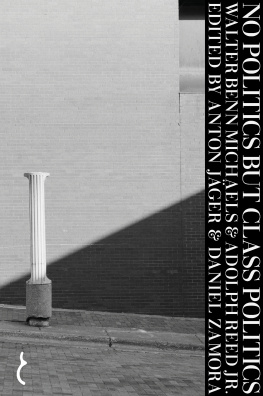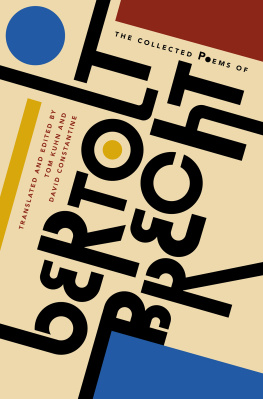The Beauty of a Social Problem
Photography, Autonomy, Economy
Walter Benn Michaels
The University of Chicago Press
Chicago and London
Walter Benn Michaels is professor of English at the University of Illinois at Chicago.
The University of Chicago Press, Chicago 60637
The University of Chicago Press, Ltd., London
2015 by The University of Chicago
All rights reserved. Published 2015.
Printed in the United States of America
24 23 22 21 20 19 18 17 16 15 1 2 3 4 5
ISBN-13: 978-0-226-21026-1 (cloth)
ISBN-13: 978-0-226-21043-8 (e-book)
DOI: 10.7208/chicago/9780226210438.001.0001
Library of Congress Control Number: 2015936984
This paper meets the requirements of ANSI/NISO Z39.48-1992 (Permanence of Paper).
For Ruth Leys and Michael Fried
Contents
Plates
. Jeff Wall, Mimic (1982)
. Viktoria Binschtok, Wand I (2006)
. Viktoria Binschtok, Das groe Medieninteresse (2008)
. Phil Chang, Two Sheets of Thick Paper on Top of Two Sheets of Thin Paper (2010)
. Phil Chang, Monochrome. Exposed (2011)
. Arthur Ou, View 1 (2008)
. Brian Ulrich, Circuit City, Ponderosa Steakhouse (2008)
. Amanda Gordon, Liz Descheness photograms reflect the crowd (2012)
Figures
. Viktoria Binschtok, Spektakel (2008)
. Frank Eugene, The Horse (ca. 1890)
. Arthur Ou, Earthworks 1 (2007)
. Arthur Ou, Untitled [Screen Test] 1 (2006)
. Arthur Ou, On Every New Thing There Lies Already the Shadow of Annihilation (2006)
. Brian Ulrich, Montgomery Ward Door Pulls (2011)
. Arthur Ou, Test Screen 2 (2011)
. Brian Ulrich, Retail 15, Chicago, Illinois (2002)
. Brian Ulrich, Randall Park Mall (2008)
. Brian Ulrich, Dominicks (2008)
. Brian Ulrich, Is This Place Great or What? (2012)
. Walker Evans, Mrs. Frank Tengle (1936)
. August Sander, Children Born Blind (ca. 1930)
. Paul Strand, Blind Woman, New York (1916)
. Walker Evans, Frank Tengle Family (1936)
. Walker Evans, Allie Mae Burroughs (1936)
. Walker Evans, Tengle Family Home (1936)
. Michael Williamson, Pictures of Fred and Sadie Ricketts (1986)
. August Sander, Photographer (1925)
. August Sander, Porter (ca. 1929)
. August Sander, SS-Hauptsturmfhrer (1937)
. August Sander, Death Mask of Erich Sander (1944)
. Walker Evans, Floyd Burroughs and Tengle Children (1936)
. Walker Evans, Frank Tengle, Bud Fields, and Floyd Burroughs (1936)
. Liz Deschenes, Untitled (2012)
. August Sander, Unemployed (1928)
. Sergej Strunnikow, Soja (1941)
. James Welling, Poe (2007)
Graphs
. The top decile income share, 19172012
. Net productivity and real hourly compensation of production/nonsupervisory workers, 19482012
. Median family net worth in dollars
. Economy-wide returns on invested capital (ROIC), 19652009
This book began with a desire to write about what seemed to me some aesthetically ambitious works of art. At first, that desire was mainly reactive. I had just written two books, one primarily theoretical (The Shape of the Signifier, 2004) and the other entirely political (The Trouble with Diversity, 2006), and I wanted to write about art. But then, moving beyond the reactive, I started seeing some photographs and reading some books by younger artists whose work seemed to me really interesting. I wanted to write in particular about them.
What attracted me was the simultaneous assertion of form and meaningan interest in what it meant for something to have form and to be meaningfuland it was in light of this interest that the age of the artists seemed significant. All of them were born after 1965 (and most in the 1970s), which is to say they were born and raised and began to study and produce art in a world where artistic ambitionespecially insofar as form might be thought to establish the works autonomy, or meaning might be understood as a function of the artists intentionswas often identified with the critique of both. Its clear not only that all of the artists I write about below have been in important ways influenced by this critique, but also that sometimes (Tom McCarthy would be the exemplary instance) they understand themselves as completely committed to it.
But its also clear (anyway, thats part of my argument) that their work is also doing something different, by which I mean that their aesthetic ambitions engage and push beyond the critique of autonomy and intentionality, the (nave) valorization of the subject, and the (more sophisticated but just as bad) valorization of the subject positionbeyond, more generally, the materialism-as-literalism of much recent theoretical writing and contemporary art practice. So part of whats interesting about these artists is not only that their work would have been unimaginable without those theoretical commitments, but that it importantly both departs and dissents from them.
The second thing that interested me (and here, again, age mattered) was that these artists have from the start been making art in an economy defined by an almost unprecedented rise in economic inequality. The Gini coefficient is a measure of inequality where 0 represents perfect equality (everybody makes the same) and 1 represents perfect inequality (one person makes everything). In 1968, the US Gini number was 0.38; by 2011, it was almost 0.48. Of course, the rise in inequality isnt the only marker of what is now standardly called the neoliberal turn, but, for my purposes, it is a crucial one because it highlights the importance of the conflicts that are constitutive of that turn. For example, the productivity of American labor is up by 80 percent since the end of the 1970s, while average wages (despite being inflated by the very high salaries of top management) are up by only about 8 percent. So labors share of income is down while corporate profitsboth as a percentage of income and in absolute numbersare higher than theyve ever been. Capitals gain has been labors loss.
And (this is the other part of my argument) its in this context of structural conflict that the emergence in art (or at least in the work of some artists) of a new commitment to form and meaning as technologies of autonomy has new political meaning. The separation of the work from the worldfrom its subject (which is what form does) and from its reader or beholder (which is what meaning does)functions here as an emblem of the relation between classes (rather than between people or subject positions; thats the importance of structure) and also of the escape from that relation, of the possibility of a world without class. So its by asserting its difference from the world that the work establishes its relation to the world.
The chapters that follow are an attempt to make both parts of this argument (the aesthetic and the political) and to make them more perspicuous and more concrete. Photography plays a crucial role because in photography the link to the world has also been identified with the primacy of the beholders response (think Barthess punctum as the reverse face of Peirces index), and so its in photography that we can see most vividly what it means to try to break that link and refuse that response. Hence, even in those chapters that are organized around literary texts, the photographbecause of the particular problems it poses for art and because of the solutions it thereby makes possibleremains central.


















